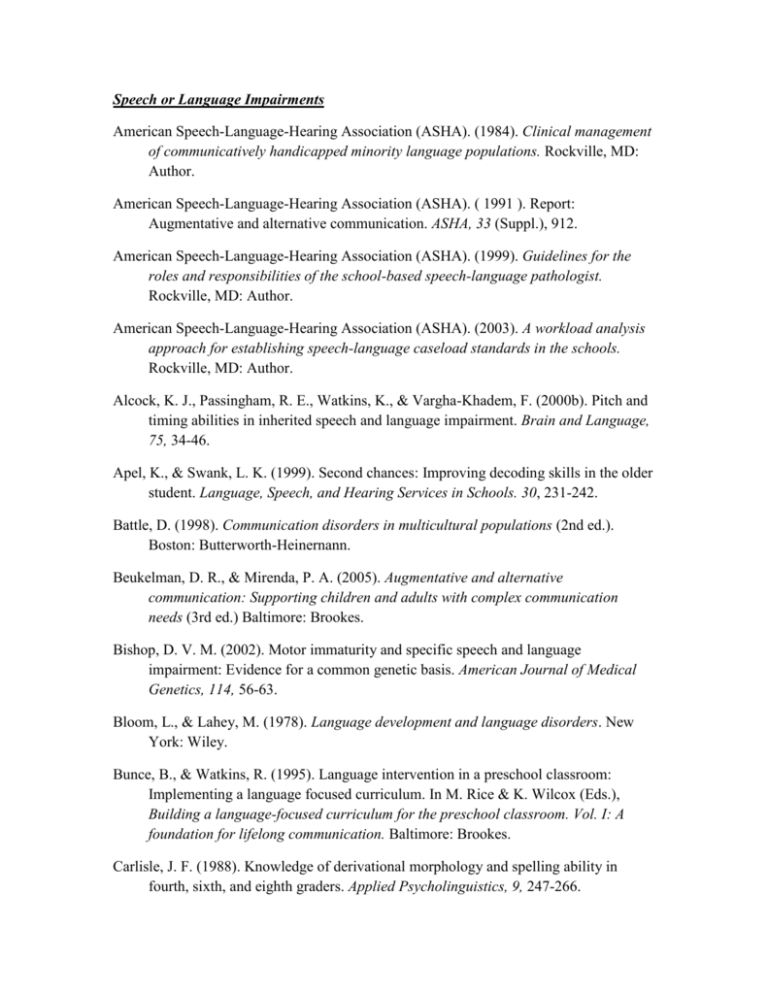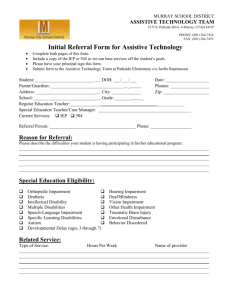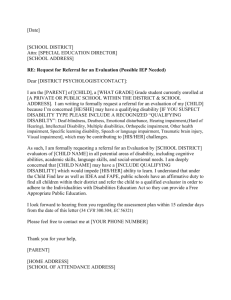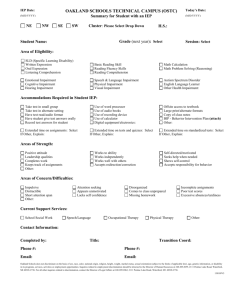Additional References
advertisement

Speech or Language Impairments American Speech-Language-Hearing Association (ASHA). (1984). Clinical management of communicatively handicapped minority language populations. Rockville, MD: Author. American Speech-Language-Hearing Association (ASHA). ( 1991 ). Report: Augmentative and alternative communication. ASHA, 33 (Suppl.), 912. American Speech-Language-Hearing Association (ASHA). (1999). Guidelines for the roles and responsibilities of the school-based speech-language pathologist. Rockville, MD: Author. American Speech-Language-Hearing Association (ASHA). (2003). A workload analysis approach for establishing speech-language caseload standards in the schools. Rockville, MD: Author. Alcock, K. J., Passingham, R. E., Watkins, K., & Vargha-Khadem, F. (2000b). Pitch and timing abilities in inherited speech and language impairment. Brain and Language, 75, 34-46. Apel, K., & Swank, L. K. (1999). Second chances: Improving decoding skills in the older student. Language, Speech, and Hearing Services in Schools. 30, 231-242. Battle, D. (1998). Communication disorders in multicultural populations (2nd ed.). Boston: Butterworth-Heinernann. Beukelman, D. R., & Mirenda, P. A. (2005). Augmentative and alternative communication: Supporting children and adults with complex communication needs (3rd ed.) Baltimore: Brookes. Bishop, D. V. M. (2002). Motor immaturity and specific speech and language impairment: Evidence for a common genetic basis. American Journal of Medical Genetics, 114, 56-63. Bloom, L., & Lahey, M. (1978). Language development and language disorders. New York: Wiley. Bunce, B., & Watkins, R. (1995). Language intervention in a preschool classroom: Implementing a language focused curriculum. In M. Rice & K. Wilcox (Eds.), Building a language-focused curriculum for the preschool classroom. Vol. I: A foundation for lifelong communication. Baltimore: Brookes. Carlisle, J. F. (1988). Knowledge of derivational morphology and spelling ability in fourth, sixth, and eighth graders. Applied Psycholinguistics, 9, 247-266. Caruso, A., & Strand, E. (1999). Clinical management of motor speech disorders in children. New York: Thieme. Catts, H., & Kamhi, A. (1999). Language and reading disabilities. Needham, MA: Allyn & Bacon. Dollaghan, C. A., & Campbell, T. F. (1998). Nonword repetition and child language impairment. Journal of Speech, Language, and Hearing Research, 41, 1136-1146. Downing, J. E. (2005). Teaching communication skills to students with severe disabilities (2nd ed.). Baltimore: Brookes. Gargiulo, R.M. (2006). Special education in contemporary society: An introduction to exceptionality. Belmont, CA: Thomson Wadsworth. Giangreco, M. (2000). Related services research for students with low-incidence disabilities: Implications for speech-language pathologists in inclusive classrooms. Language, Speech, and Hearing Services in Schools, 31(3), 230-239. Gillon, G. (2000). The efficacy of phonological awareness intervention for children with spoken language impairment. Language, Speech, and Hearing Services in Schools, 31, 126-141. Gillon, G. (2004). Phonological awareness: From research to practice. New York: Guilford Press. Goffman, L. (1999). Prosodic influences on speech production in children with specific language impairment. Journal of Speech, Language, and Hearing Research, 42, 1499-1517. Goffman, L. (2004). Kinematic differentiation of prosodic categories in normal and disordered language development. Journal of Speech, Language, and Hearing Research, 47, 1088-1102. Hill, E. L. (2001). Non-specific nature of specific language impairment: A review of the literature with regard to concomitant motor impairments. International Journal of Language and Communication Disorders, 36, 149-171. Hill, E. L., Bishop, D., & Nimmo-Smith, L. (1998). Representational gestures in developmental coordination disorder and specific language impairment: Error-types and the reliability of ratings. Human Movement Science, 17, 655-678. Hulit, H., & Howard, M. (2002). Born to talk: An introduction to speech and language development (3rd ed.). Boston: Allyn & Bacon. Jancke, L., Siegenthaler, S., Preis, S., & Steinmetz, H. (2006). Decreased white-matter density in a left-sided frontotemporal network in children with developmental language disorder: Evidence for anatomical anomalies in a motorlanguage network. Brain and Language, 102, 91-98. Kail, R. (1994). A method for studying the generalized slowing hypothesis in children with specific language impairment. Journal of Speech and Hearing Research, 37, 418-421. Leonard, L. B. (1998). Children with specific language impairment. Cambridge, MA: MIT Press. MacNeilage, P. F. (2008). The origin of speech. Oxford, England: Oxford University Press. McCormick, L. (2003). Introduction to language acquisition. In L. McCormick, D. Loeb, & D. Schiefelbusch (Eds.), Supporting children with communication difficulties in inclusive settings: School-based language intervention (2nd ed., pp. 1-42). Boston: Allyn & Bacon. McCormick, L., & Loeb, D. (2003). Characteristics of students with language and communication difficulties. In L. McCormick, D. Loeb, & D. Schiefelbusch (Eds.), Supporting children with communication difficulties in inclusive settings: Schoolbased language intervention (2nd ed., pp. 71-112). Boston: Allyn & Bacon. McGregor, K. K., & Leonard, L. B. (1994). Subject pronoun and article omissions in the speech of children with specific language impairment: A phonological interpretation. Journal of Speech and Hearing Research, 37, 171-181. Miller, C., Kail, R., Leonard, L., & Tomblin, J. B. (2001). Speech of processing in children with specific language impairment. Journal of Speech, Language, and Hearing Research, 44, 416-433. Nagy, W., Berninger, V., Abbott, R., Vaughan, K., & Vermeulen, K. (2003). Relationship of morphology and other language skills to literacy skills in at-risk second-grade readers and at-risk fourth-grade writers. Journal of Educational Psychology, 95, 730-742. Nathan, L., Stackhouse, J., Goulandris, N., & Snowling, M. (2004). The development of early literacy skills among children with speech difficulties: A test of the “critical age hypothesis.”.Journal of Speech, Language, and Hearing Research, 47, 377391. Nelson, N., & Van Meter, A. (2004). The writing lab approach to language instruction and intervention. Baltimore: Brookes. Owens, R. (2005). Language development: An introduction (6th ed.). Boston: Allyn & Bacon. Paradis, J. (2010). The interface between bilingual development and specific language impairment. Applied Psycholinguistics, 31(2), 227-252. Pannbacker, M. (1999). Treatment of vocal nodules: Options and outcomes. American Journal of Speech-Language Pathology, 8(3), 209-217. Powell, R. P.,&Bishop, D. V. M. (1992). Clumsiness and perceptual problems in children with specific language impairment. Developmental Medicine and Child Neurology, 34, 755-765. Rice, M., & Wexler, K. (1996). Toward tense as a clinical marker of specific language impairment in English speaking children. Journal of Speech, Language, and Hearing Research, 39, 1239-1257. Romski, M. A., & Sevcik, R. A. (1996). Breaking the speech barrier: Language development through augmented means. Baltimore: Brookes. Semel, E., Wiig, E. H., & Secord, W. A. (1992). Clinical Evaluation of Language Fundamentals—Preschool. San Antonio, TX: The Psychological Corporation. Shankweiler, D., Lundquist, E., Dreyer, L., & Dickinson, C. (1996). Reading and spelling difficulties in high school students: Causes and consequences. Reading and Writing: An Interdisciplinary Journal, 8, 267-294. Stuart, S. (2002). Communication: Speech and language. In M. Batshaw (Ed.), Children with disabilities (5th ed., pp. 229-241 ). Baltimore: Brookes. Turnbull, A., Turnbull, R. & Wehmeyer, M. L. (2007). Exceptional lives: Special education in today's schools. Upper Saddle River, NJ: Pearson Merrill Prentice Hall. Ullman, M. T., & Pierpont, E. I. (2005). Specific language impairment is not specific to language: The procedural deficit hypothesis. Cortex, 41, 399-433. Verdolini, K. (2000). Voice disorders. In J. Tomblin, H. Morris, & D. Spriestersbach (Eds.), Diagnosis in speech-language pathology (2nd ed., pp. 233-280). San Diego: Singular. Wang, P. P., & Baron, M. A. (1997). Language and communication: Development and disorders. In M. L. Batshaw (Ed.), Children with disabilities (4th ed., pp. 275-292). Baltimore: Brookes. Windsor, J. (2000). The role of phonological opacity in reading achievement. Journal of Speech, Language, and Hearing Research, 43, 50-61.








